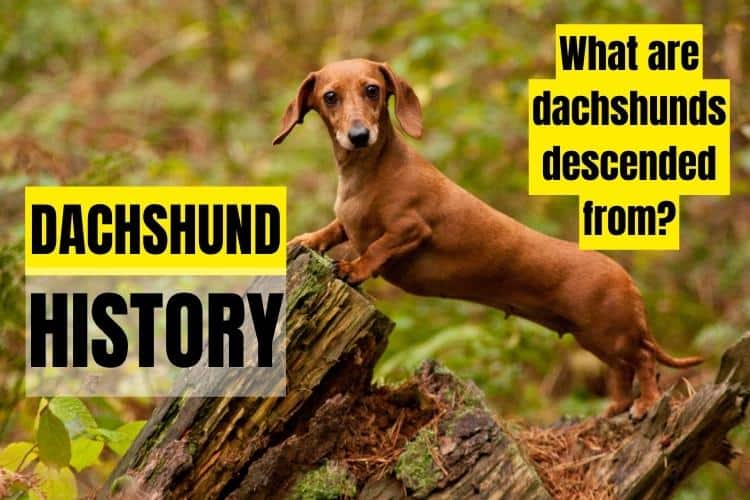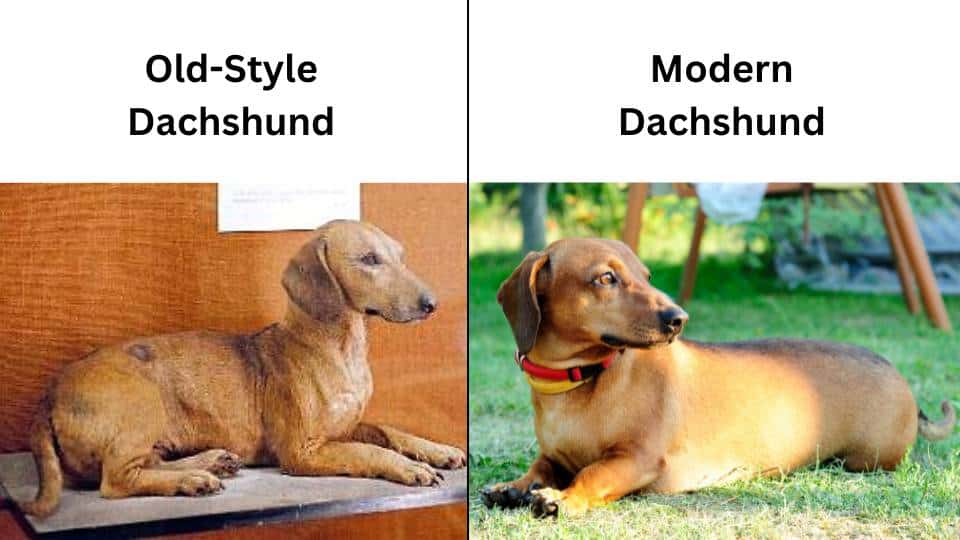
- Ancestry of the Dachshund: What are dachshunds descended from?
- Dachshund Origins: When did dachshunds originate?
- The appearance of the Original Dachshund: How did old-school dachshunds look like?
- Breed Composition: What Breeds Make up a Dachshund?
- Dachshunds in World Wars I & II
- Dachshunds as Germany's Symbols
- Conclusion
The Dachshund, a widely recognizable breed, has a rich and interesting history. To comprehend the breed’s origins, personality, and physical characteristics, exploring its history is crucial. This article will uncover the breed’s past, including its ancestry, origin, physical appearance changes, role in World War II, and composition of breeds.
Ancestry of the Dachshund: What are dachshunds descended from?
The Dachshund breed was created by crossbreeding various hunting dogs including German, English, and French hounds and terriers. The goal was to develop a dog capable of hunting badgers, hence the breed’s name “dachshund,” meaning “badger dog.” They resemble other hound breeds, but their elongated bodies and short legs make them unique. The shape was designed for them to follow their prey’s scent into dens and burrows. The breeds used in their creation, such as the Basset Hound, Bloodhound, and German Pointer, were selected for their hunting abilities, scenting skills, and tenacity. The exact origin of the breeds used is not known.
Related post: What were dachshunds bred for?
Dachshund Origins: When did dachshunds originate?
The origin of the Dachshund breed is uncertain, but some trace it back to the 15th century. They are believed to have originated in Germany in the late 17th century for hunting badgers. Over time, they gained popularity among hunters and were used for various hunting and tracking tasks. Today’s Dachshunds have evolved from their ancestors, but still, retain many of their successful hunting traits.
The appearance of the Original Dachshund: How did old-school dachshunds look like?
The original Dachshunds were similar in appearance to today’s Dachshunds, with elongated bodies and short legs. However, they were larger, weighing 30-40 lbs, compared to today’s 16-32 lbs. They were bred in two varieties, straight-legged and crook-legged, with the modern Dachshund descending from the crook-legged type. The original Dachshunds were more heavily muscled and had a rugged appearance. Distinct features such as floppy ears and a curved tail have been bred into the breed for specific purposes. The ears prevent debris from entering the ear canal, and the tail makes the dog more visible in tall grass and helps pull them if stuck in a burrow.
Related post: Why are Dachshunds so long?

Breed Composition: What Breeds Make up a Dachshund?
The smooth-haired dachshund, the oldest variety, may have originated from a blend of German Shorthaired Pointer, Pinscher, and Bracke (a bloodhound-type) or by cross-breeding a short Bruno Jura Hound and a Pinscher. Some claim it was created by mating a miniature French pointer and Pinscher or descended from the 18th-century St. Hubert Hound or Basset Hounds for their scenting and appearance. Despite the theories, the exact origin remains a mystery.
However, it’s established that the smooth dachshund is the progenitor of both the long-haired and wire-haired varieties. There are two explanations for the origin of long-haired dachshunds: either they were selectively bred from smooth dachshunds with occasional longer hair or cross-bred with various spaniel breeds.
Wire-haired dachshund, the newest variety, was developed in the late 19th century, likely by breeding smooth dachshunds with wire-haired terriers and pinschers such as the Schnauzer, Dandie Dinmont Terrier, German Wirehaired Pointer, or Scottish Terrier.
Knowing the breeds that make up a dachshund is crucial for comprehending the breed’s traits and personality, and making informed decisions when picking a dachshund as a pet.

Dachshunds in World Wars I & II
Dachshunds have long been regarded as a symbol of Germany, and political cartoonists often depicted the breed to mock the country. During World War I, dachshunds’ popularity in the US declined due to this association, leading owners to refer to them as “liberty hounds.” The stigma was briefly revived during World War II, albeit to a lesser extent.
Dachshunds as Germany’s Symbols
Due to its popularity among Munich dog owners and its association with Germany, the dachshund was chosen as the first official mascot for the 1972 Summer Olympics in Munich, named Waldi.
Conclusion
The dachshund breed has a rich and intriguing history, from its origin to its use in World Wars and the breeds that make it up. Understanding our pets’ history is essential for appreciating their unique qualities and deeper comprehension. By learning about the dachshund breed, one can appreciate this fascinating and beloved pet even more. Whether you’re a dachshund owner, fan, or simply interested in pet history, studying the dachshund’s history is a fulfilling experience.
Related post: Are Dachshunds Hunting Dogs?



